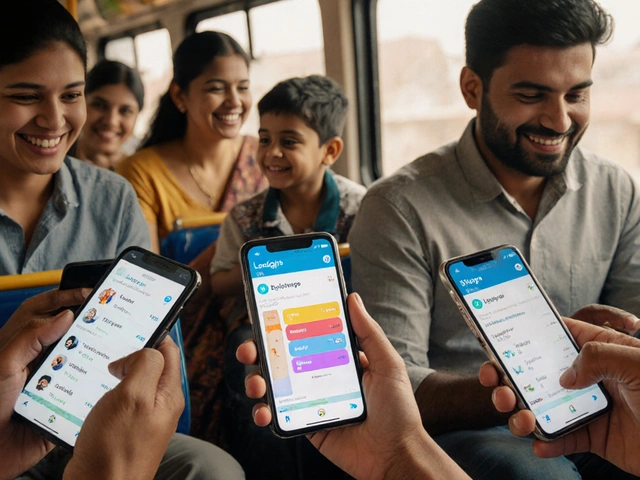Imagine this: you're stuck between two doors. One leads to Python, the other to HTML. Both are wildly popular, but you can only pick one as your first coding language. Let's be real—this isn't just a coin flip. Your choice will set the vibe for your entire programming journey.
What Makes Python and HTML Different?
Let’s start by clearing the fog around what these two words even mean. Python is a general-purpose programming language. In plain English, you can use Python for nearly anything—building apps, running data analysis, powering AI, or automating boring tasks. HTML, or Hypertext Markup Language, isn’t a programming language at all. It’s a markup language, like the frame that gives a webpage its structure—headings, paragraphs, links, images, the lot.
This single fact is a game changer: Python lets you talk to computers and tell them to crunch numbers, fetch data, or even reply to your emails automatically. HTML, on the other hand, is more like the blueprint for putting text and images where you want them on a website. Think of Python as the chef cooking up meals (making programs do things) and HTML as the restaurant’s floor plan (deciding what goes where).
Here’s something wild—almost every website you visit, from Wikipedia to Instagram, uses HTML as its skeleton. But their brains? That’s where real programming happens, often with Python, JavaScript, or another language. If you want to see websites and understand what’s under the hood, knowing HTML will feel like having X-ray vision. But if you’re after solving problems, creating real automation, or diving into tech heavyweights like machine learning, Python’s your ticket in.
Check out this side-by-side look at the basics:
| Feature | Python | HTML |
|---|---|---|
| Type | Programming Language | Markup Language |
| Main Use | Software/app/web backend, data science, automation | Webpage structure |
| Interactivity | Can build logic, process data, automate tasks | No logic, just layout |
| Difficulty for Beginners | Low to Medium | Very Low |
| Learning Curve | Start simple, then deep and wide | Flat and easy |
| Job Opportunities | Software, tech, finance, AI | Web design, front-end basics |
The coolest part? You don’t have to master one before peeking at the other. A lot of coders switch back and forth, but the order does make life smoother at the start. HTML gives instant gratification—you see changes live on a page. Python flexes deeper mojo, but sometimes that initial spark feels slower.
Why Some Beginners Choose HTML First
A ton of newbies start with HTML, and it makes sense. Why? Formatting a webpage is super visual. You can change a header, reload your browser, and see it pop up right away. No hunting for bugs, no mysterious error messages. HTML works like digital Legos—you stack squares, change colors, and see things take shape.
Here’s a pro tip: if the thought of building your own blog, portfolio, or CV website gets you pumped, jump into HTML. You’ll get your hands dirty fast and see something real show up after each line you write. Want more? Add some CSS to jazz it up, or sprinkle in a pinch of JavaScript for interactive magic. But if you just want to dip your toes in, HTML gives you a welcoming start—no downloadable tools or command-line hassles.
For kids and true beginners, HTML is forgiving. Leave out a tag, and your browser just shrugs. There’s not a lot of “breaking” you can do. And the basics—like heading tags (<h1>, <h2>), paragraph tags (<p>), and links (<a>)—are intuitive. You’ll recognize them the next time you ‘view source’ on any webpage.
The downside is also pretty clear: HTML’s ceiling is low. It can’t handle numbers, make decisions, or create anything that acts on its own. HTML by itself is static; it won’t ever be “smart.” That’s why folks itching to build games, apps, or anything interactive feel stuck quickly and go looking for the next challenge. Still, it shines if instant feedback fires you up. Just expect to switch gears soon if your dreams go beyond static pages.
Want real-world proof? Someone once built a digital greeting card business using just basic HTML and free webpage builders, raking in enough cash to pay rent for a whole year. No joke. The learning curve for HTML is gentle—kids as young as 10 cobble together their first pages in an hour. If you want a confidence boost, HTML won’t let you down.

The Case for Starting With Python
Now let’s flip to the Python side. Learning Python first isn’t just a trend—it’s a strategy. Python’s biggest weapon is how readable and human-friendly it is. If you hated math in school or struggled with puzzle-like logic, Python feels almost like plain English. Here’s an actual ‘Hello, World!’ in Python: print("Hello, World!"). That’s it.
Pythons’ real muscle flexes in problemsolving. You can build calculators, automate repetitive tasks, scrape data from websites, or analyze massive tables with just a few lines. Python is everywhere; Google, NASA, Netflix, Spotify, and Instagram all use it for mission critical stuff. Even Harvard’s first coding class dumped Java in favor of Python in 2017, and it’s remained that way because more students finish—and understand—the course.
Python opens more doors the deeper you go. Want to make a game? Try Pygame. Interested in artificial intelligence? Libraries like TensorFlow and PyTorch make it beginner-friendly. Into automation? Python can schedule your Zoom meetings, rename 2000 files, or pull images from Instagram—all while you grab coffee.
If you want a job in tech, especially in 2025, Python’s the skill hiring managers love. According to Stack Overflow’s 2024 Developer Survey, Python is the third most wanted programming language by employers, only trailing behind JavaScript and SQL. It also pays off: according to Glassdoor, the average entry-level Python developer in the US makes around $85,000 a year.
Starting with Python can be a bit daunting if you’ve never tinkered with code. You’ll need to set up Python on your computer, possibly use a terminal, and grasp basic logic. But most people learn enough Python to build real things in just a few weeks. And when you get stuck? The Python community is legendarily helpful. There’s a subreddit with 1.7 million learners and experts ready to explain anything.
Python’s not perfect for everyone, though. If you only want to make websites, it won't help for page layouts—HTML is mandatory. But if you’re curious about what computers can really do for you, Python’s flexibility is wild. Automation, data, games, AI, the works. Python’s ‘power per line’ is off the charts.
How to Pick: Ask Yourself These Questions
So you’re still tossing the coin. Here’s how to get unstuck—just answer these questions honestly:
- Do you want to see your work on a website immediately? If yes, start with HTML.
- Do you dream of automating tasks, crunching numbers, or building apps? Go Python.
- Is troubleshooting “syntax errors” a turnoff? HTML is more forgiving at first.
- Do you want a portfolio piece quickly? HTML gets you there faster.
- Is a high-paying job in tech your target? Python unlocks more doors in 2025.
- Are you under 16 or helping a younger learner? HTML is less scary and more visual.
Here’s a quirky tip: try both! Spend one hour tinkering with each. Whichever feels more exciting, stick with it for a week. Coding is intensely personal, and the excitement you feel is a better compass than forums or friends’ opinions.
If you’re all about web dev, here’s the real roadmap: HTML first, then sprinkle in CSS (for style), then JavaScript (for interactivity), and finally Python (for web app backends). If you want to go the data or automation route—maybe you’re sick of Excel or want a chatbot—then jump feet-first into Python.
The job market is wild for both, but more so for Python. HTML alone is never enough—after a few weeks, you’ll want more. But starting simple gives you confidence. If you stick around in coding, you’re going to end up learning both anyway. The biggest thing? Don’t overthink it—picking either Python or HTML as your first step means you’re miles ahead of anyone still sitting on the fence.




